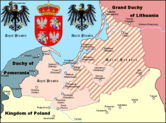- You may also be looking for the 1807 Battle of Allenstein.
| Siege of Allenstein | |||||||
|---|---|---|---|---|---|---|---|
| Part of the Polish–Teutonic War (1519–21) | |||||||
 Warmia (Ermland) surrounded by the Duchy of Prussia founded in 1525 | |||||||
| |||||||
| Belligerents | |||||||
| Kingdom of Poland |
| ||||||
| Commanders and leaders | |||||||
| Nicolaus Copernicus[2] | Wilhelm von Schaumber[3] | ||||||
| Strength | |||||||
| 200 infantry, several hundred dismounted cavalry[3] | 400 infantry, 600 heavy cavalry, 400 light cavalry[3] | ||||||
| Casualties and losses | |||||||
| unknown | unknown | ||||||

The siege of Allenstein or the siege of Olsztyn took place from January 1521 to February 1521, during the Polish–Teutonic War (1519–1521).
The town of Allenstein (Olsztyn) was defended by Polish forces against those of the Monastic Order of the Teutonic Knights. The defense of the town was successfully organized and coordinated by astronomer and scholar Nicolaus Copernicus.[2][4] The Polish forces successfully resisted the Teutonic Knights, who eventually had to lift the siege.[1] By the end of 1521 the Teutonic Knights were forced to ask for an armistice and in 1525 the Grand Master of the Order, Albrecht Hohenzollern, paid homage to the Polish king, Sigismund the Old.[5]
- ^ a b Cite error: The named reference
Repwas invoked but never defined (see the help page). - ^ a b Jerzy Jan Lerski, Piotr Wróbel, Richard J. Kozicki, "Historical dictionary of Poland, 966-1945", Greenwood Publishing Group, 1996, pg. 403, [1]
- ^ a b c Cite error: The named reference
Kurswas invoked but never defined (see the help page). - ^ Marcus Hellyer, "The scientific revolution: the essential readings", Wiley-Blackwell, 2003, pg. 47, [2]
- ^ Cite error: The named reference
Moorewas invoked but never defined (see the help page).